Last year, my older gelding Khami, at 24, was diagnosed with Cushings. This is common for older horses these days. But there are many things that can be done to maintain the health of an older horse so that his organs and other body parts function well, in spite of the aging process.
One thing that happens to aging horses is that their organs will sag, where the belly looks like a hay belly and the musculature and ligamenture come away from the topline. Most common is a swayback, which is common to a horse with a long back but can occur with a horse with a regular length back too.
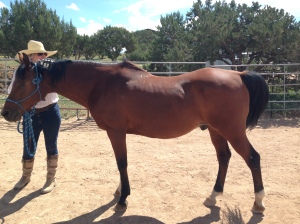
While doing bodywork on Khami, I found that his intestines were sagging with his sway back. Everything else about him: his coat, his demeanor, all suggest great health, and he doesn’t look like a horse who has Cushings. The big indicators for his diagnosis were remodeling of the hoof and extreme, sudden weight loss.
I developed an exercise program for Khami – not just trail riding, but something more yoga-like, to lift the belly, in addition to the bodywork, herbs and everything else we’re doing for him.
To get into a little anatomy here, the abdominal wall is formed from layers of muscle which include the external abdominal oblique, internal abdominal oblique and transverse abdominal. These layers support the weight of the viscera, which includes the intestines and stomach. In addition, the abdominal muscles have attachments to the ribs and attach to the dense tendinous sheet that covers the loins, as well as to the haunch bones, and ilia (hip bones), and the pubic region of the pelvic bones (ischium). How the weight of the viscera is distributed is in all the directions of these muscle attachments as well as with the rectus abdominus in the midline of the horse’s belly. So there is a lot involved in the abdomen when the horse’s viscera starts to drop. Imagine the pull on dense structure and/or the sagging of those muscles and how uncomfortable that is, as well as how it affects the overall body long term.
Just like for people, this will vary with horses. Some horses have short backs and never experience this musculature and ligamenture pulling away from structure. Some breeding is more prone to the swayback and loss of integrity along the spine than others. I met a beautiful 24-year-old Andalusian gelding recently with a short back and beautiful topline. He has done classical dressage for most of his life, and is in tiptop shape. Because I spend more time on trail, my arena work doing lateral bending work and/or using the body in a yoga-like way, is not as strong. There are only so many horse-hours in a day!
The proverbial belly-lifts are not really enough, because they do not invite the horse to lift his own belly. In order to lift his own belly and engage his thoracic vertebrae and the muscles of the abdomen and ribcage, some bends and lateral work needed to be added to Khami’s program. The trail is wonderful but we generally travel in straight lines, unless of course, Khami jumps sideways at a jackrabbit or something. Yet he can do that without bending. That’s why I needed to add the bend to his program.
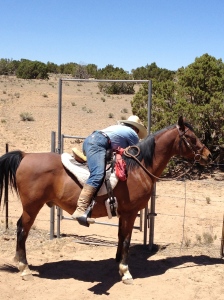
Fortunately, he is still very nimble for an old guy. He has almost completed 2,000 miles of endurance competition in his past life, a star in my eyes, although many horses have accomplished way more than that. I find that horses that have had an active competitive life do well in retirement, if they continue to get exercise.
My 22-year-old mare Zuzka doesn’t have quite the sag because she has a short back. She also uses her hindquarters more efficiently. Both of my geriatric horses have very good lateral movement and agility, although they tend to get stiff sometimes.
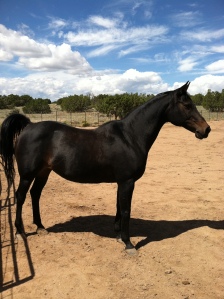
I devised these exercises that have been thought of before for other purposes, to address the problem of the muscle tone and organ position.
Ground work
For lifting:
1) Cavaletti – These cavaletti don’t have to be formal – just some timbers or PVC pipe will do. You can also get some blocks to raise them up a little higher.
2) Half pass along the fence – This is a good one for horses who are still agile enough to do them. Good for both lifting the body, muscle tone and for bending.
Bending
3) Spirals – For horses who some difficulty with the bend, start with some loose spirals in each direction, starting with the easiest direction.
4) Larger circles
Circles are classic for initiating bend. With an older horse we don’t want to do too tight of a circle at first because often the joints and ligaments can’t manage that, especially if he hasn’t had much training on the circle. I will always start with riding the direction the horse is most comfortable, and the size of the circle that is comfortable, before asking for anything else. Usually a circle will expose any discomfort or restriction.
5) Ponying
If you have two horses, you can pony one. I can weave in and out of the juniper trees while riding to give more of a bend to each horse’s body. This can also be done riding one horse.
6) Lunging

I use lunging for health, not to “get the bucks out.” Lunging can be helpful for a horse with any body restrictions. Neck, shoulder, ribs all benefit from this exercise, if done correctly and just on a long line and halter.
With Liberty Foundation training, I can often “free lunge” a horse without any lead at all, but the horse must already be trained to do this. I want the horse to find its own comfort on the circle, not hampered by side reins or bits, etc. I find in some cases, that having the lead on for therapeutic reasons, is more helpful because there is a tangible line we can both refer to in our work. Again, I only do this when the horse is able to maintain a circle on a line. Otherwise I will do it at liberty and/or walk the circle with a horse.
These groundwork exercises can be done in or out of the saddle.
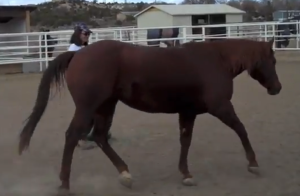
Foot placement
6) Foot placement is very important. If you watch how your horse puts his feet down, sometimes walking on the outside of one forefoot or both, you can learn a lot. Some older horses drag their hind feet. Some place one fore or hind in front of the other.
By walking purposefully beside your horse, heel to toe, in a meditative way, you can change the way your horse places his own feet on the earth. Soon, you get good at hearing the horse’s footfalls and knowing whether he is dragging his hooves or placing his feet rhythmically on the ground. This can be done with a halter and lead or at liberty if you know how to do this. I combine this one with going over cavaletti when possible.
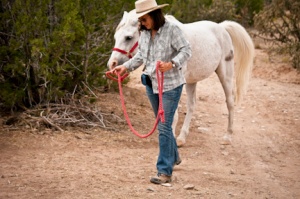
Summary
I recall being at a dressage barn once where many horses were lame, largely because they didn’t have enough room to move around. The owners of lame horses were very upset that they couldn’t ride, and didn’t know what they could do with their horses! There is almost always something you can do with your horse.
Some horses really can’t do much bending so you get them to move in the direction that is most comfortable and hold a position for 30 seconds or so. Other horses can’t lift their legs high enough to do cavaletti raised off the ground. The bend of the lunge circle may be too much for others.
I go with the comfort of the horse, and don’t expect him or her to do something that is beyond their capacity. At that same barn I described, there was an owner who wanted me to treat her 24-year-old horse because he could no long do piaffes and some other fancy moves. He wasn’t interested in working, she said. It was clear to me he wasn’t interested in working at that level. He might like it if she calmed down and they went on a simple hack around the grounds. She was clueless about his age, abilities and how he felt about all of it.
Here are some videos, a number of them doing a few exercises at liberty, because my horses enjoy doing them that way or with a liberty rein. Not all the horses featured are older, but I tailor the work to their needs and abilities. These exercises are intended to reduce stiffness, increase circulation and flexibility and have a good time with your older horse or horse recovering from injury.
[youtube https://www.youtube.com/watch?v=uC-v8Ji57_g&w=560&h=315] [youtube https://www.youtube.com/watch?v=bYhYNmnVgu8&w=420&h=315] [youtube https://www.youtube.com/watch?v=D-FS90k6cVw&w=420&h=315]****
(copyright: Susan Smith, OrthoHorse)
Services: Bodywork (Ortho-Bionomy for people, Equine Ortho-Bionomy): private sessions, tutorials, phone consultations, Horse & Rider sessions, distance healing communication and gift certificates
Liberty Coaching: clinics, mini-clinics, workshops, private and semi-private sessions, tutorials, consultations: by appointment: 505.501.2478 or emailing susansmith@orthohorse.info Scheduling now. Contact me for details.
September 26 – Spirit Horse Ranch – Private Liberty Lessons & Ortho-Bionomy for both people and horses. OrthoHorse Tutorial 9-12. Contact me 505-501-2478 or Ruella at 405-771-4274 (ruella@libertyfoundations.com)
September 27-28 – Spirit Horse Ranch Two-Day Liberty Foundations Clinic, Oklahoma City, Oklahoma – Engaging the Hearts and Minds of Horses. Susan Smith and Ruella Yates, co-teaching. Contact me 505-501-2478 or Ruella at 405-771-4274 (ruella@libertyfoundations.com)
October 7: Liberty Foundations Online classes – beginning and advanced – offered by Susan Smith (October 7-beginning), four calls, and Ruella Yates (October 7-advanced), Horses at Liberty Online and Spirit Horse Ranch Online. PayPal button available on my website homepage and on the Events page. Contact me for other payment arrangements.
December 13-14 – Horses at Liberty Weekend Clinic, DeLand, Florida – Bring your Horse into Deep Working Connection with Liberty Horsemanship. Instructor: Susan Smith. Contact Anne Daimler tdaimler@cfl.rr.com (386-822-4564) Susan at susansmith@orthohorse.info (505-983-2128 or cell 505-501-2478) 9:00-4:30 p.m.
Susan is a member of the Independent Liberty Trainers Network. libertytrainersnetwork.com/



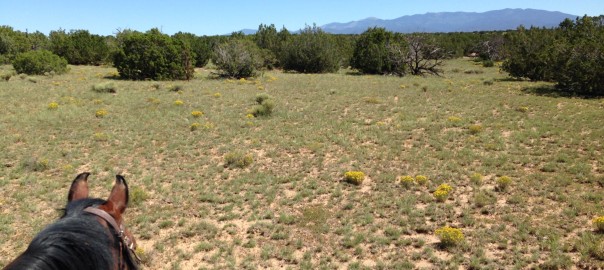

Hi, and thanks for really good advices and exercises!!!
Kerstin